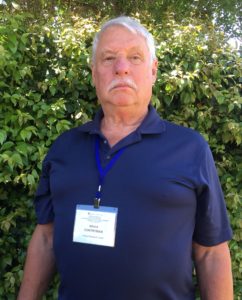Hello I am Bruce Contryman, as a kid on the plains of Nebraska,
I would look up at the Milky Way and stare in wonder at the bands of stars across the night sky.
I went back to college when I was 28, and graduated 4 years later from the
University of Nebraska at Lincoln in 1972 with a Bachelors of Science degree in Electrical Engineering. I am an honorary member of
ETA KAPPA NU and SIGMA TAU.
I would like to tell you a bit about my background and how I became an expert at solving problems.
I have spent spent 35 years in the telecommunications industry and the last 22 years were with Fujitsu Business Communications Systems. My forte at this company was solving very difficult problems until they promoted me to Director of Engineering. I became an expert on their Private Branch Exchange (PABX).
It was designed by Fujitsu for small businesses with 100 to 200 telephone lines to be manufactured and sold in the United States. They designed this PABX using delta modulation, sampling the voice 800,000 times per second as 1’s and 0’s to switch the signal from one line to another.
I solved many problems on this PABX by trying different solutions until I narrowed the problem down.
One of the most difficult problems was with their Frequency Shift Keying (FSK) card. This card was designed to send user data information from the PABX to the public telephone system (PTS) for billing purposes.
The FSK signal didn’t work correctly and the PTS couldn’t interpret the data. I was asked to take a new card to our customers business and install it to see if it would correct the problem. This was the first time I had seen this FSK card.
At this time I was a member of the IEEE TRS 41 committee that was tasked with writing the specifications for the interface network between these new PABXs and the PTS.
I called one of my colleagues on this committee and asked his input on what the problem could be? He suggested that it was probably harmonic distortion caused when switching from one frequency to another frequency.
The next day I traveled to the customers city and checked in to my hotel room and went to bed.
During the night I lay there thinking about this problem and just knew if I plugged this new card into the customers PABX that it would have the same issue as the existing card.
I finally got up and pulled out the schematic drawings. I studied the circuitry and identified the circuit that controlled the shift from one frequency to the other. I determined the algorithm the Fujitsu engineers used to make the shift from one frequency to the other. I calculated a new algorithm that maintained the same count and steps but with a smoother transition of 1’s and 0’s.
I took out my X-Acto knife and made about 12 cuts on the printed circuit board which is about 9” by 11”. I then started soldering jumper wires to make my new algorithm circuit. I double checked all the modifications with my volt/ohm meter. When I was satisfied I went back to bed.
The next morning I went to the customers site early, pulled out the old card, installed the newly modified card and powered the system back up.
I placed test calls through the PABX to the PTS, the test desk operator verified that all the test calls went through and that the FSK data was transmitted correctly.
I packed up all my gear and the old FSK card and returned to my office. About three months later Shaw-san our resident Fujitsu engineer approached me and said that their Fujitsu engineering group had approved my modification.
I have since retired from FBCS and I’m now the Chief Engineer for Vertical Research Center.
I am always designing and building projects in the lab. When I have a problem with a design or I don’t understand an issue I ponder the problem and then sleep on it.
Many times I will wake up in a slumber mode and my mind goes through all the possibilities and I have a plan of action for the next day.
After retiring from FBCS, a colleague and I developed a fuel cell utilizing Proton exchange membrane (PEM) material. We built about 5 devices making improvements each time, again with my own funding. We were successful in getting the fuel cell to work, and after extensive testing, we determined that the design we were using, used a lot of copper and the power losses in the copper were about 30% of the available power. I decided that this design was not feasible.
I am also developed a palm top computer back in
1984 that could recognize hand writing. I worked with a software engineer, who applied the operating system and developed the software recognition algorithms. This Palm top computer used a touch sensitive pad to recognize input. I developed a business plan with my own funds, but was not successful in getting funded.

